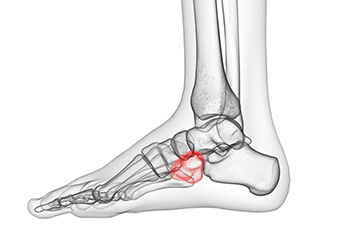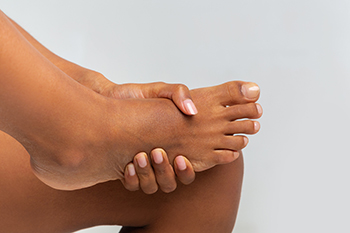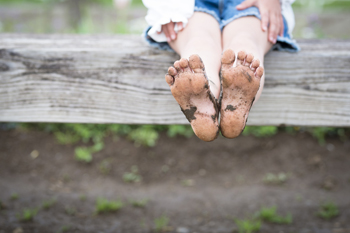Dr. Kennan T. Runte, DPM, FACFAS
Dr. Panah Nabili, DPM
Grass Valley, CA 95945
Dr. Kennan T. Runte, DPM, FACFAS
Dr. Panah Nabili, DPM

The body’s need for speed and movement starts with the feet. They are considered to be the foundation of the body, and for the majority of the population, they are essential in completing daily activities. The gait is known as the walking style, and this movement may be measured to learn how an individual walks, runs, and moves. There are various parts to the foot bones, consisting of the forefoot, midfoot, and hindfoot. The back of the foot, which is also known as the hindfoot, is found under the ankle joint and is composed of two bones. Five bones are found in the midfoot, located in the center of the foot. The forefoot is the front of the foot, which houses the metatarsals, phalanges, and sesamoid bone. The foot bones and ankles work together to produce a smooth walk, which is made up of two phases, consisting of the swing and stance phases. The ankle and muscles in the front and back of the leg enable the foot to move up and down, and the transverse tarsal joint propels the foot to move forward. If you would like additional information about how the ankle and feet work together, please consult with a podiatrist who can provide you with the information you are seeking.
If you have any concerns about your feet, contact one of our podiatrists from Foothill Podiatry Clinic. Our doctors can provide the care you need to keep you pain-free and on your feet.
Biomechanics in Podiatry
Podiatric biomechanics is a particular sector of specialty podiatry with licensed practitioners who are trained to diagnose and treat conditions affecting the foot, ankle and lower leg. Biomechanics deals with the forces that act against the body, causing an interference with the biological structures. It focuses on the movement of the ankle, the foot and the forces that interact with them.
A History of Biomechanics
Modern technological improvements are based on past theories and therapeutic processes that provide a better understanding of podiatric concepts for biomechanics. Computers can provide accurate information about the forces and patterns of the feet and lower legs.
Understanding biomechanics of the feet can help improve and eliminate pain, stopping further stress to the foot.
If you have any questions please feel free to contact our office located in Grass Valley, CA . We offer the newest diagnostic and treatment technologies for all your foot and ankle needs.

The cuboid bone is found below the ankle on the inside of the foot and can become forced out of alignment during an injury. This is known as cuboid syndrome. Common symptoms can include swelling, pain, and inflammation in the ankle, and it can be difficult to walk. The pain from this condition is felt on the outside of the foot, and it may cause the toes to turn toward each other. The discomfort may gradually become worse when activities are pursued, and it can hurt to stand on tiptoes. Cuboid syndrome is diagnosed by having an X-ray taken, in addition to performing a physical examination. Research has indicated that it is beneficial to wear shoes that have adequate support, and enough room for the toes to move freely in. If you have pain in this part of your ankle and foot, it is strongly urged that you contact a podiatrist as quickly as possible so the correct treatment can begin.
Cuboid syndrome, also known as cuboid subluxation, occurs when the joints and ligaments near the cuboid bone in the foot become torn. If you have cuboid syndrome, consult with one of our podiatrists from Foothill Podiatry Clinic. Our doctors will assess your condition and provide you with quality foot and ankle treatment.
Cuboid syndrome is a common cause of lateral foot pain, which is pain on the outside of the foot. The condition may happen suddenly due to an ankle sprain, or it may develop slowly overtime from repetitive tension through the bone and surrounding structures.
Causes
The most common causes of cuboid syndrome include:
Symptoms
A common symptom of cuboid syndrome is pain along the outside of the foot which can be felt in the ankle and toes. This pain may create walking difficulties and may cause those with the condition to walk with a limp.
Diagnosis
Diagnosis of cuboid syndrome is often difficult, and it is often misdiagnosed. X-rays, MRIs and CT scans often fail to properly show the cuboid subluxation. Although there isn’t a specific test used to diagnose cuboid syndrome, your podiatrist will usually check if pain is felt while pressing firmly on the cuboid bone of your foot.
Treatment
Just as the range of causes varies widely, so do treatments. Some more common treatments are ice therapy, rest, exercise, taping, and orthotics.
If you have any questions, please feel free to contact our office located in Grass Valley, CA . We offer the newest diagnostic and treatment technologies for all your foot care needs.

A blister is the body’s natural defense against skin that has become injured or burned. It appears like a small bubble that is filled with liquid and acts as a protective barrier between the skin and the environment until new skin has formed underneath it. Blisters develop for various reasons, including excess friction that happens from wearing shoes and socks that don't fit correctly, in addition to an allergic reaction from an insect bite. Some people have medical conditions that may produce blisters, including eczema and psoriasis. Possible infection may be avoided when the blister is not prematurely popped. The blister will gradually drain when the area is healed, and the skin will be a light pink until it returns to its normal color. It is advised that you consult with a podiatrist if you are afflicted with continuous blisters, who can advise you on what types of shoes to buy, or what you may be allergic to.
Blisters may appear as a single bubble or in a cluster. They can cause a lot of pain and may be filled with pus, blood, or watery serum. If your feet are hurting, contact one of our podiatrists of Foothill Podiatry Clinic. Our doctors can provide the care you need to keep you pain-free and on your feet.
Foot Blisters
Foot blisters are often the result of friction. This happens due to the constant rubbing from shoes, which can lead to pain.
What Are Foot Blisters?
A foot blister is a small fluid-filled pocket that forms on the upper-most layer of the skin. Blisters are filled with clear fluid and can lead to blood drainage or pus if the area becomes infected.
Symptoms
(Blister symptoms may vary depending on what is causing them)
Prevention & Treatment
In order to prevent blisters, you should be sure to wear comfortable shoes with socks that cushion your feet and absorb sweat. Breaking a blister open may increase your chances of developing an infection. However, if your blister breaks, you should wash the area with soap and water immediately and then apply a bandage to the affected area. If your blisters cause severe pain it is important that you call your podiatrist right away.
If you have any questions, please feel free to contact our office located in Grass Valley, CA . We offer the newest diagnostic and treatment technologies for all your foot care needs.

Stress fractures are a common occurrence among people who enjoy running. A stress fracture, also known as a hairline fracture, generally occurs due to excessive strain on the foot bones. Stress fractures may result from increasing speed or distance too quickly and can be a runner's worst nightmare. The number of stress fractures may be reduced when good running shoes are worn, in addition to stretching the feet before and after running. Many runners experience an emotional condition that is known as runner’s blues. This may happen from the inability to run as the healing process occurs. This can take several weeks, depending on how severe the fracture is. Many people choose to use crutches as this can help restore mobility. If you have foot pain, please consult a podiatrist who can determine if a stress fracture has occurred and can offer you treatment options.
Stress fractures occur when there is a tiny crack within a bone. To learn more, contact one of our podiatrists from Foothill Podiatry Clinic. Our doctors can provide the care you need to keep you pain free and on your feet.
How Are They Caused?
Stress fractures are the result of repetitive force being placed on the bone. Since the lower leg and feet often carry most of the body’s weight, stress fractures are likely to occur in these areas. If you rush into a new exercise, you are more likely to develop a stress fracture since you are starting too much, too soon. Pain resulting from stress fractures may go unnoticed at first, however it may start to worsen over time.
Risk Factors
Stress fractures do not always heal properly, so it is important that you seek help from a podiatrist if you suspect you may have one. Ignoring your stress fracture may cause it to worsen, and you may develop chronic pain as well as additional fractures.
If you have any questions, please feel free to contact our office located in Grass Valley, CA . We offer the newest diagnostic and treatment technologies for all your foot care needs.

Heel pain in children is usually not serious or lasting. If a child complains of such pain, has tenderness in the back of their foot or ankle, or is limping or walking on their toes, they may be suffering from one of several conditions. A few common causes of heel pain in children are Sever’s disease, Achilles tendinitis, and plantar fasciitis. Sever’s disease can cause heel pain in children who participate in sports and are between 5 and 11 years of age. Experts believe it develops from the pull of the Achilles tendon on the still growing heel bone. Achilles tendinitis, where the Achilles tendon gets inflamed, might be the culprit of heel pain, particularly if the child has a sudden increase in repetitive activity. Plantar fasciitis is also an overuse injury that involves irritation of the plantar fascia, the thick band of connective tissue that runs along the arch from the heel to the toes. It is usually worse in the morning and improves as the day wears on. These kinds of injuries typically resolve with rest. However, it is important to see a podiatrist if your child complains of heel or foot pain in order to get a proper diagnosis and treatment plan.
Making sure that your children maintain good foot health is very important as they grow. If you have any questions, contact one of our podiatrists of Foothill Podiatry Clinic. Our doctors can provide the care you need to keep you pain-free and on your feet.
Keeping Children's Feet Healthy
Having healthy feet during childhood can help prevent medical problems later in life, namely in the back and legs. As children grow, their feet require different types of care. Here are some things to consider...
Although babies do not walk yet, it is still very important to take care of their feet.
Avoid putting tight shoes or socks on his or her feet.
Allow the baby to stretch and kick his or her feet to feel comfortable.
As a toddler, kids are now on the move and begin to develop differently. At this age, toddlers are getting a feel for walking, so don’t be alarmed if your toddler is unsteady or ‘walks funny’.
As your child gets older, it is important to teach them how to take care of their feet.
Show them proper hygiene to prevent infections such as fungus.
Be watchful for any pain or injury.
Have all injuries checked by a doctor as soon as possible.
Comfortable, protective shoes should always be worn, especially at play.
If you have any questions please feel free to contact our office located in Grass Valley, CA . We offer the newest diagnostic and treatment technologies for all your foot and ankle needs.